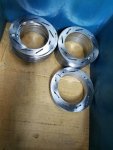OK, I'll ask it....why does a person need A/C for an indoor pool? Isnt diving into the water to get cool the whole point of a pool?
One may think that but with a heated pool and spa contained indoors, without dehumidification and A/C it would literally rain in there. The temperature would rise above 90* and it would be very uncomfortable. The fixtures, walls, etc would rust and rot. Mold would be everywhere.
I tried just just replacing the air with as much CFM as the unit could provide and while it could keep the temps in check on cold days it couldn't handle the humidity. Not much over 60% RH and the windows fog up.
Being at a hotel, much of the swimmers are the kids with the parents sitting on the side. Even if it didn't bother the swimmers it would for everyone else.
Another sister hotel had to have all the walls ripped out and gutted because of the mold. I would like to avoid that.
Before I started the doors had corrosion on them and the closers where shot from rust. Sprinkler heads had to be replaced. Of course a new unit would be nice but money only trickles up not down in the hotel business
Nice as-build drawings. :thumb:
That was my first attempt. I scribbled it out in about 10 minutes to help me wire it up. While it did work, it never shut off and had no control over humidity.
I need to update it to coincide with the added changes








